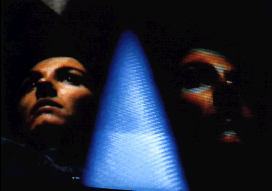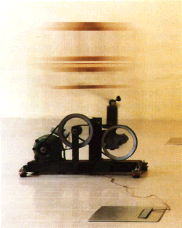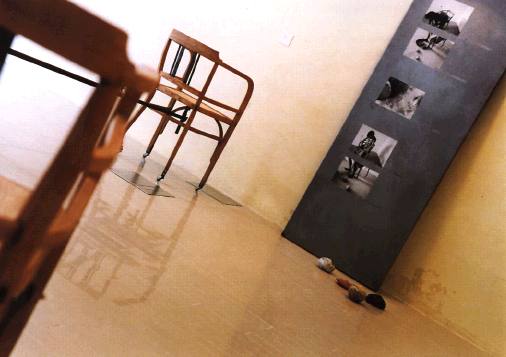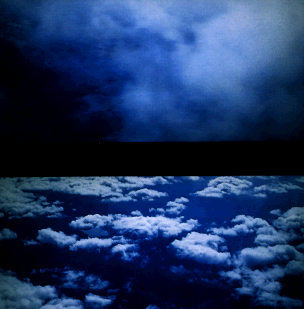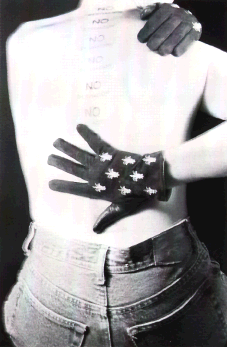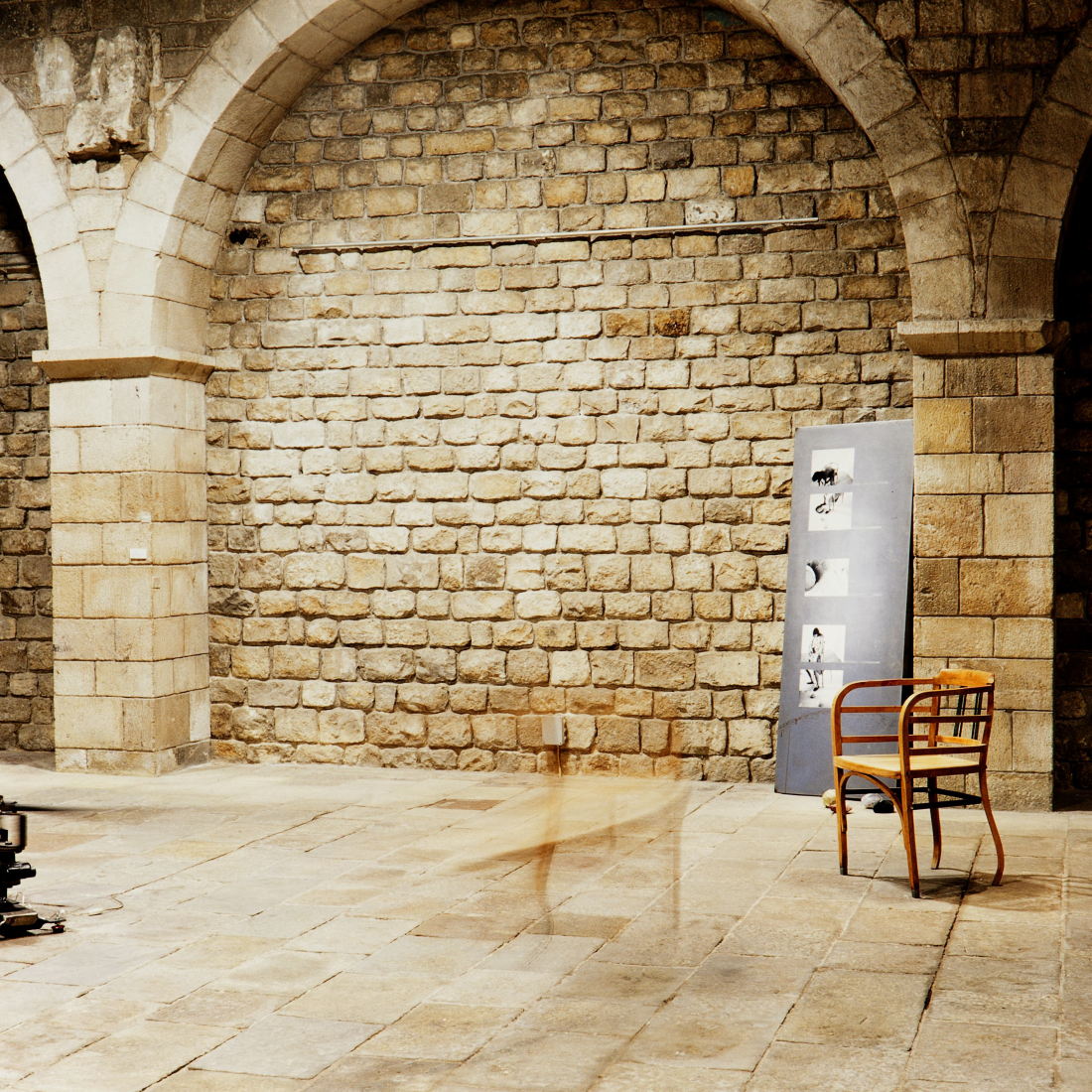La veu en primera persona, femení, singular
Where is the artist? The space of the different ones
The photography of a performance called Auvegle Voix (Voice Blind, 1975), of the missing Korean-American artist Theresa Hak Kyung Cha, opens on the cover this third catalog. It is an image that relates the language, the presence of the artist in the work, the sense of sight, the silence / visibility and the term "voice", which I used to baptize this cycle of 'Exhibitions dedicated to critical reflection on artists and their productions.
In an article in the early 1990s entitled "Where is the artist?", Linda S. Klinger was investigating precisely the relationship between post-structuralist theories about authorship, art practice and the feminist project. Throughout the text, he explained that since the seventies, one of the fundamental points on the agenda of the movement of women artists - and also, it must be added, of all the disciplines where feminist concerns have had an important echo - has been the dismantling of myths of the psychology of creation that have excluded and discarded the majority of creative voices throughout history. In this sense, the famous article by Craig Owens << The Discourse of Others: Feminism and Postmodernism >> also recognized the important task of deconstruction of traditional authorship with decision for feminism in the theory and arts of the eighties. Klinger reached the center point of his reflection when he warned of the particular assumptions that the dissolution of the author and the consequent "subject" crisis could have on the basis of the feminist projects, which have their reason to be precisely in the claim of women as a creative subject-agent. In this sense, Klinger warns of the danger that the voice of the artist woman is again diluted in what, for example, the philosopher Celia Amorós calls, referring to the situation of women writer at the time of the birth of the modern subject , << the space of the identical >>, in which it is not recognized in the principle of individualization and in which it was automatically excluded from the role of author.
Klinger argues, through three works by very different American artists -Carolee Schneemann, Clarisa Sligh and Cindy Sherman-, which was precisely the claim of this authorship on the part of women where the necessary reformulation of an author's idea that the artist contemplates and his gesture as a producer and product of a historical, gender and political reality. It is at this point where the question "where is the artist?" Or the reflection on the "voice" takes its meaning.
The works of the three artists who present this third exhibition of the cycle << Polifonies. The metaphor of the voice >> -My Guiteras, Sonsoles García-Ramos and Carme Viñas- want to offer different perspectives on these issues. The question "where is the artist?" Is, then, a reflection on the identity of the artist woman and the forms from which today she articulates her presence in her own production.
Matrilineatges
In the work he did for the Tona Town Hall, the Millennium (1995), Guiteras decided to choose among the referents of his own history three objects that belong to a silent tradition: a sleeping shirt made by his grandmother, his mother's jewelery box and her own photography working on the millennial sculptural reproduction (a demarcation stone of a Roman road found in the vicinity of the population). These three objects wanted to be the correlates of three symbols that are situated as references in the history of Tona, from where the artist is originally: the same millennium, an old musical score and a dressing needle of the time Matrilineal seems to indicate in the artist's language a certain self-awareness of gender identity. I think it interesting to cite a reflection of the philosopher Fina Birulés to provide a more global dimension to this individual gesture of the artist.
<< But our identity does not depend exclusively on the capacity that we show to reappropriate ourselves from the past, not only do we measure the fragments of 'already been', but, thanks to the roundup of the narration, we also express what is' not yet '. That is to say, in the same gesture we tell ourselves about the mediation of a story about how things have happened and how we would like them to be. From this point of view, perhaps it is not at all contradictory to affirm that women, in a sense, must enter the future by retreating >>.
The narration by Guiteras authorizes the history of a lost story when he evaluates these intimate objects in the field of public territory and gives them voice through his own artist. In this way, not only is the past transformed from "we," which does not represent a category of definition of essential femininity, but rather a political action that transforms the gesture of the private sphere into an open word.
Esqueixada stone (1996), the work shown at the Architects' Association and Vic in the exhibition Thambos 2, currently exhibited in La Capella, is included, in my opinion, within the same line of reflection. With this work the artist began a work on the subject of menstruation that is currently under development. The installation we observe in this exhibition originated from an artist's action that consisted of pouring red paint on the dress. In the installation, the action is documented in the black and white photographs shown on the rusty iron panel, accompanied by a small poem. The chair in which he performed the action remains unoccupied and static. In front of it, another empty chair travels through the floor, driven by an engine that is joined by an axis. A last element is the stones lined with different materials: laurel leaves, velvet, clothing that the artist was carrying on the action ... All of them have an open or closed cut, in the form of vaginal lips, wounds or scars in the middle of this second skin that envelops you.
The installation is complemented and continues in this exhibition with an investigation detail that consists of some surveys made by the artist on the subject of menstruation. The questions are addressed to viewers, men and women, and invite them to participate in the project.
The intention of the artist is not to intimidate the public nor to provoke it, nor to elaborate statistics of any kind on the subject. On the one hand, Guitera introduces the responses of the public through a video as an integral part of the work. On the other hand, and this is one of the key aspects, the artist indicates that contrary to the traditional readings about menstruation and the own experience of the body of women, these issues do not belong nor are they defined in an exclusive and fictitious << natural >> personal and female scope. Like the very concept of << woman >>, these issues, which are intimately linked to the traditionally essentialist definitions of femininity, require an open and global reading to treat them as myths, taboos, and legends, and above all, that the Discover, like other ideas attached to femininity, as terms of social and cultural scope.
Sonsoles García-Ramos
Trams between seeing and thinking
Report, infinite, unattainable, fluent, incomprehensible, and unbreakable, seems to present the outside reality in the eyes of this artist. A Something of Chaos (1993) and Paisajes de mano (1993), two series of six forms of plasticine on pedestals, the properties of this material - its malleability and the ability to conglomerate the additions and heal the subtractions - evoke the amorphous, ductile and passive character of matter. Forms do not become mass reports or finished figures, nor records of random prints or transfers of individual and transcendental gesture. The photographs of aerial landscapes - in twelve light boxes aligned on the walls of the small chapel - do not reveal clear intentions either. Rather they seem fragments of discontinuous views of an incommensurable landscape that could be prolonged infinitely. Reality seems to be kept there, outwardly, alien, continuous, and in an imagined innocent state.
However, the artist is present, between the veins of colors, like a bosso in this conglomerate of shapes, in the depth of black and in the textures of the plates, and as a cloud, corporeal and incorporeal, transparent and dense, stratum and cluster, spreading out, flicking out, letting the landscape unearthly between the interrupted clearings. Oh, Zambrano and his << Clear from the forest >>!
García-Ramos's work seems to be placed, then, halfway between the sensory image, the moment when it begins to be processed and the first impulse that the artist has pushed to find it; in a strange coexistence of the eye, with the point of view and with the gaze; of perception, perspective and poetry, denying the point of flight; in a stratum between seeing and thinking; when the thought is not recognized but it feels that it is still corpore, taken from impulses and desire, wandering without destiny, free and captive in the stretches of indeterminacy between the << want to be >> and << the being >>, between the << want to say >> and << the say >>.
In one of his writings of poetic tone, the artist says that he looks for << to be in this first impulse that conforms the intention >>. His work would, then, be to pour into the outside through a glance that subtly sits on the outside, from an attempt to capture his eyes over things, about to reason them, At the time of encounter between going to look for them and being given to us.
On the other hand, this philosophical-poetic exercise essayes the objectivization of << I >>. This << I >> that, on the other side, coexists promiscuously with an essence of the real, also fluid. << To be there outside when you look> or << the landscape as an extension of the body that is established with the look >> writes the artist in his notes.
Perhaps only from this perspective is it possible to see things at once from within and from outside. Not having to choose between fusion and distance, between continuity and discontinuity, between being and appearance. Perhaps only from this point of view it is possible to see with this global look that it includes the totality. Thus, the landscapes become recorded by the bold end of a pencil in their drawings - curious coincidence that this widget traditionally associated with female eyes was chosen by the artist after successive tests - seems to transcribe those unrecognizable sections between seeing and thinking. Perhaps, remembering Cage and Bach, these drawings could be the scores for a continuous bass.
Carme Viñas
As a (b) old (des) known
Although the option of making the most immediate experiences material and work topic is common to a large number of young artists and writers (women and men), the work of Carme Viñas does not denote the naive teenage voice that It tries to talk about the purity of the "most intimate" self. There is, on the other hand, an interesting constant game of distances and encounters between women, the artist, the sick person and the author. His insistence on the unfolding of his image (reflected, maquillada, projected, cosified, imagined) is related to the work of Cindy Sherman. However, the option of Vines for << action >> as a form of work consistently includes, in my opinion, a very important topic of his speech that is not dealt with in the case of the photographic works of the American artist . This aspect is the need not to renounce the intensity of experience as an inescapable point in the reflection on << I >> and also as an element to put into play in this schizophrenic dance in the search / construction of its multiple faces The idea of the autobiography that the artist works is, then, the consciousness of a << I >> mutant, inaprensible, that is lost and recovered, bored and esteemed, is built and is undone in his writings and in the images.
(no) deviation (1995) is a work that is born as an action and originated in the reflection of the artist on the acceptance of his illness and the deformation of his own body, specifically the deviation of his column vertebral Currently includes a documentary video of the action, blue bulletins to be shared among the public-where the term << (no) deviation >> is defined and a fragment of the artist's diary is included (<< ... I got up some mornings with an intense trembling due to the smell of bones in friction, without lubrication. I lost four inches of flexibility backwards: curving forward. The impossibility of movement determined at the same time my possibility of feeling, my moods and my decisions >>) and some post-action photographs. However, like all its incipient work, essentially actions, any attempt to establish limits to what is defined as input as an open work is invalidated at the beginning. In addition, the work of Carme Viñas is one of those cases in which it is not a topic to talk about the intertwining of life and work. His artistic production wants to be shaped precisely at the confluence, as she underlines, from the thought, the act and the position (the action).
One of the photographs that we present in the exhibition and reproduced in the catalog brings new elements to the original action. The hands of the artist in beautiful precious embroidered black velvet gloves seem to feel and hide at the same time the deviant stretch of his column. This scene did not take place in the original action and seems to go beyond the courageous act of self-awareness that suggests one of the photographs is linked to the new action that the artist intends to carry out on the day of the inauguration of This exhibition: (with) neckline (1996). With the same gloves and stitches and trimmed with a party dress that frames elegantly and reveals his back, the artist will walk through the room evidencing in his << a normality >> not as an object of the show but as author and self-conscious subject of the prediction of the drama.
In the action of life (color of pink) (1995), the artist wrote in the ticket that offered to the spectators: "we consider a life of pink that which although well aware of deviations, transits and the emotions, you like >>. In one of the actions carried out at the Castle of Montesquiu, Espais per Carme (1995), from which we reproduce two images, the artist appeared on the screen of the duplicate monitor thanks to a combination of video camera, direct circuit of television, mirror and light At some moments his face and his hand seemed to peck at each other, suggesting an ambiguous attitude between self-recognition and open self-complacency. If, in the work of García-Ramos, we pointed to a still-bodily thinking, in the one of Viñas we can speak of a self-conscious body, that on the one hand resists any gesture of objectivation and at the same time recognizes the mirage of wanting represent the << subject >>.



